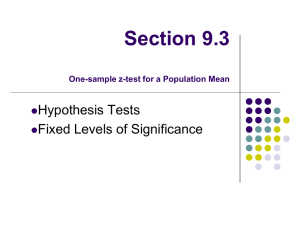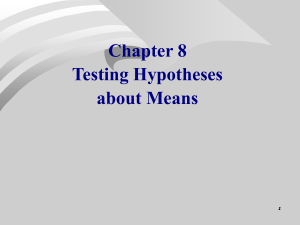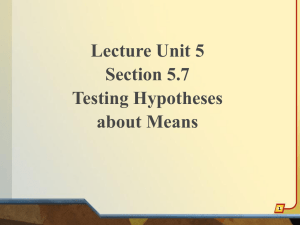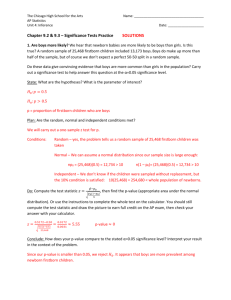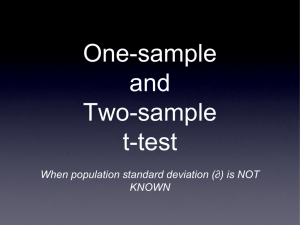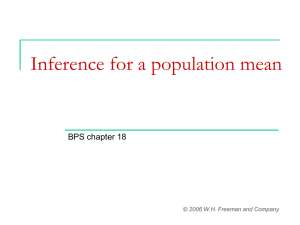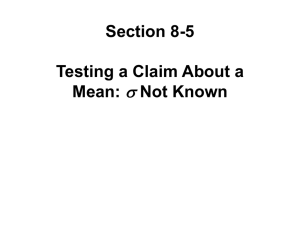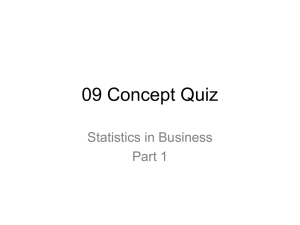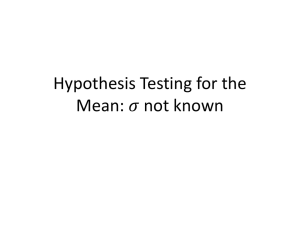Chapters 23, part 1 powerpoints only
advertisement
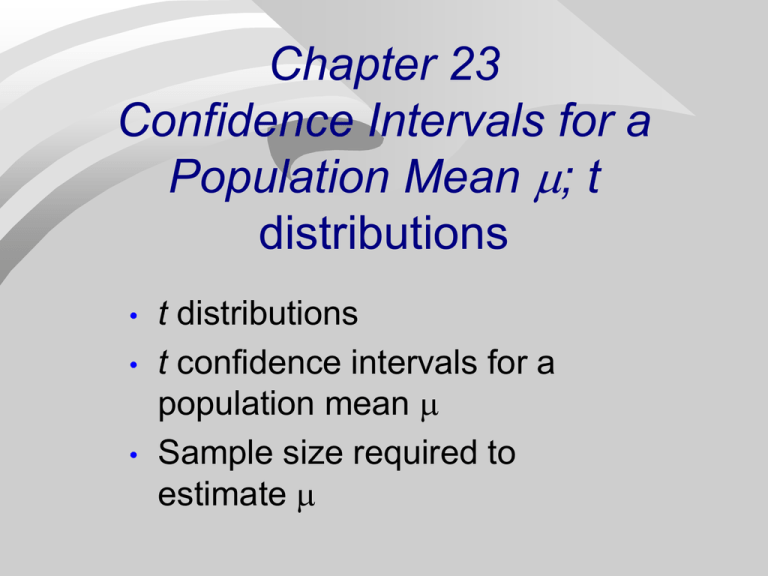
Chapter 23 Confidence Intervals for a Population Mean ; t distributions • • • t distributions t confidence intervals for a population mean Sample size required to estimate The Importance of the Central Limit Theorem When we select simple random samples of size n, the sample means we find will vary from sample to sample. We can model the distribution of these sample means with a probability model that is N , n Since the sampling model for x is the normal model, when we standardize x we get the standard normal z x z n Note thatSD( x ) n SD( x ) If is unknown, we probably n don’t know either. The sample standard deviation s provides an estimate of the population standard deviation For a sample of size n, the sample standard deviation s is: 1 2 s ( x x ) i n 1 n − 1 is the “degrees of freedom.” The value s/√n is called the standard error of x , denoted SE(x). s SE( x ) n Standardize using s for Substitute s (sample standard deviation) for x x z zs s s s s ss s n n Note quite correct Not knowing means using z is no longer correct t-distributions Suppose that a Simple Random Sample of size n is drawn from a population whose distribution can be approximated by a N(µ, σ) model. When is known, the sampling model for the mean x is N(, /√n). When is estimated from the sample standard deviation s, the sampling model for the mean x follows a t distribution t(, s/√n) with degrees of freedom n − 1. x t s n is the 1-sample t statistic Confidence Interval Estimates CONFIDENCE INTERVAL for s x t n where: t = Critical value from tdistribution with n-1 degrees of freedom x = Sample mean s = Sample standard deviation n = Sample size For very small samples (n < 15), the data should follow a Normal model very closely. For moderate sample sizes (n between 15 and 40), t methods will work well as long as the data are unimodal and reasonably symmetric. For sample sizes larger than 40, t methods are safe to use unless the data are extremely skewed. If outliers are present, analyses can be performed twice, with the outliers and without. t distributions Very similar to z~N(0, 1) Sometimes called Student’s t distribution; Gossett, brewery employee Properties: i) symmetric around 0 (like z) ii)degrees of freedom if > 1, E(t ) = 0 if > 2, = - 2, which is always bigger than 1. Student’s t Distribution x - x z = x x - x s t = , sx = sx n Z -3 -3 -2 -2 -1 -1 00 11 22 33 Student’s t Distribution z= x - x x - x t= s n n Z t -3 -3 -2 -2 -1 -1 00 11 22 33 Figure 11.3, Page 372 Student’s t Distribution Degrees of Freedom s = x - x t= s n s2 n s2 = 2 (X X) i i=1 Z n -1 t1 -3 -3 -2 -2 -1 -1 00 11 22 33 Figure 11.3, Page 372 Student’s t Distribution Degrees of Freedom s = x - x t= s n s2 n s2 = 2 (X X) i i=1 Z n -1 t1 t7 -3 -3 -2 -2 -1 -1 00 11 22 33 Figure 11.3, Page 372 t-Table: text- inside back cover 90% confidence interval; df = n-1 = 10 Degrees of Freedom 1 2 . . 10 0.80 3.0777 1.8856 . . 1.3722 0.90 6.314 2.9200 . . 1.8125 0.95 0.98 12.706 4.3027 . . 2.2281 31.821 6.9645 . . 2.7638 . . . . . . . . . . 100 1.2901 1.282 1.6604 1.6449 1.9840 1.9600 s 90% confidenceint erval: x 1.8125 11 2.3642 2.3263 0.99 63.657 9.9250 . . 3.1693 . . 2.6259 2.5758 Student’s t Distribution P(t > 1.8125) = .05 P(t < -1.8125) = .05 .90 .05 -1.8125 0 .05 1.8125 t10 Comparing t and z Critical Values z = 1.645 z = 1.96 z = 2.33 z = 2.58 Conf. level 90% 95% 98% 99% n = 30 t = 1.6991 t = 2.0452 t = 2.4620 t = 2.7564 Example – An investor is trying to estimate the return on investment in companies that won quality awards last year. – A random sample of 41 such companies is selected, and the return on investment is recorded for each company. The data for the 41 companies have x 14.75 s 8.18 – Construct a 95% confidence interval for the mean return. s x t n x 14.75 s 8.18 degrees of freedom 41 1 40 d. f . n 1 from t - t able, t 2.0211 s 8.18 x t 14.75 2.0211 n 41 14.75 2.61 12.14,17.36 W e are 95% confidentt hat t heint erval (12.14,17.36)cont ainst hepopulat ionmean ret urn on invest mentfor companiest hat win qualit y awards. Example Because cardiac deaths increase after heavy snowfalls, a study was conducted to measure the cardiac demands of shoveling snow by hand The maximum heart rates for 10 adult males were recorded while shoveling snow. The sample mean and sample standard deviation were x 175, s 15 Find a 90% CI for the population mean max. heart rate for those who shovel snow. Solution s x t n d. f . n 1 x 175, s 15 n 10 From t he t - t able, t 1.8331 15 175 1.8331 175 8.70 10 (166.30, 183.70) We are 90% confidentt hat t heint erval (166.30,183.70)cont ainst hemean maximumheart rat efor snow shovelers EXAMPLE: Consumer Protection Agency Selected random sample of 16 packages of a product whose packages are marked as weighing 1 pound. From the 16 packages: x 1.10pounds, s .36 pound a. find a 95% CI for the mean weight of the 1-pound packages b. should the company’s claim that the mean weight is 1 pound be challenged ? EXAMPLE s x t n d. f . n 1 95% CI, n=16, df=15, x=1.10 s=.36 critical value of t is t 2.1315 s x t becomes n .36 1.10 (2.1315) 1.10 .19 .91, 1.29 16 Since 1 pound is in the interval, the company's claim appears reasonable. Chapter 23 Testing Hypotheses about Means 22 Sweetness in cola soft drinks Cola manufacturers want to test how much the sweetness of cola drinks is affected by storage. The sweetness loss due to storage was evaluated by 10 professional tasters by comparing the sweetness before and after storage (a positive value indicates a loss of sweetness): We want to test if storage results in a loss of sweetness, thus: Taster Sweetness loss 1 2 3 4 5 6 7 8 9 10 2.0 0.4 0.7 2.0 −0.4 2.2 −1.3 1.2 1.1 2.3 H0: = 0 versus HA: > 0 where is the mean sweetness loss due to storage. We also do not know the population parameter , the standard deviation of the sweetness loss. The one-sample t-test As in any hypothesis tests, a hypothesis test for requires a few steps: 1. State the null and alternative hypotheses (H0 versus HA) a) Decide on a one-sided or two-sided test 2. Calculate the test statistic t and determining its degrees of freedom 3. Find the area under the t distribution with the t-table or technology 4. State the P-value (or find bounds on the P-value) and interpret the result The one-sample t-test; hypotheses Step 1: 1. State the null and alternative hypotheses (H0 versus HA) a) Decide on a one-sided or two-sided test H0: = 0 versus HA: > 0 (1 –tail test) H0: = 0 versus HA: < 0 (1 –tail test) H0: = 0 versus HA: ≠ 0 2 –tail test) The one-sample t-test; test statistic We perform a hypothesis test with null hypothesis H : = 0 using the test statistic y 0 t SE ( y ) where the standard error of y is . s SE ( y ) n When the null hypothesis is true, the test statistic follows a t distribution with n-1 degrees of freedom. We use that model to obtain a P-value. The one-sample t-test; P-Values Recall: The P-value is the probability, calculated assuming the null hypothesis H0 is true, of observing a value of the test statistic more extreme than the value we actually observed. The calculation of the P-value depends on whether the hypothesis test is 1-tailed (that is, the alternative hypothesis is HA : < 0 or HA : > 0) or 2-tailed (that is, the alternative hypothesis is HA : ≠ 0). 27 P-Values Assume the value of the test statistic t is t0 If HA: > 0, then P-value=P(t > t 0) If HA: < 0, then P-value=P(t < t 0) If HA: ≠ 0, then P-value=2P(t > |t0|) 28 Sweetening colas (continued) Is there evidence that storage results in sweetness loss in colas? H0: = 0 versus Ha: > 0 (one-sided test) t y 0 s 1.02 0 2.70 n 1.196 10 P value P(t9 2.70) Conf. Level Two Tail One Tail df 9 0.1 0.9 0.45 0.3 0.7 0.35 0.5 0.5 0.25 0.1293 0.3979 0.7027 0.7 0.3 0.15 0.8 0.9 0.2 0.1 0.1 0.05 Values of t 1.0997 1.3830 1.8331 0.95 0.05 0.025 0.98 0.02 0.01 0.99 0.01 0.005 2.2622 2.8214 3.2498 Taster Sweetness loss 1 2.0 2 0.4 3 0.7 4 2.0 5 -0.4 6 2.2 7 -1.3 8 1.2 9 1.1 10 2.3 ___________________________ Average 1.02 Standard deviation 1.196 Degrees of freedom n−1=9 2.2622 < t = 2.70 < 2.8214; thus 0.01 < P-value < 0.025. Since P-value < .05, we reject H0. There is a significant loss of sweetness, on average, following storage. Finding P-values with Excel TDIST(x, degrees_freedom, tails) TDIST = P(t > x) for a random variable t following the t distribution (x positive). Use it in place of t-table to obtain the P-value. – x is the absolute value of the test statistic. – Deg_freedom is an integer indicating the number of degrees of freedom. – Tails specifies the number of distribution tails to return. If tails = 1, TDIST returns the one-tailed P-value. If tails = 2, TDIST returns the two-tailed P-value. Sweetness in cola soft drinks (cont.) t y 0 s 1.02 0 2.70 n 1.196 10 2.2622 < t = 2.70 < 2.8214; thus 0.01 < p < 0.025. 31 New York City Hotel Room Costs The NYC Visitors Bureau claims that the average cost of a hotel room is $168 per night. A random sample of 25 hotels resulted in y = $172.50 and s = $15.40. H0: μ = 168 HA: μ 168 New York City Hotel Room Costs H0: μ = 168 HA: μ 168 t, 24 df .079 .079 n = 25; df = 24 y $172.50, s $15.40 yμ 172.50 168 t 1.46 s 15.40 n 25 Conf. Level Two Tail One Tail df 24 0.1 0.9 0.45 0.3 0.7 0.35 0.5 0.5 0.25 0.1270 0.3900 0.6848 0.7 0.3 0.15 0.8 0.9 0.2 0.1 0.1 0.05 Values of t 1.0593 1.3178 1.7109 0 -1. 46 1. 46 P-value = .158 P value 2P(t 1.46) 0.95 0.05 0.025 0.98 0.02 0.01 0.99 0.01 0.005 2.0639 2.4922 2.7969 0.1 ≤ P-value ≤ 0.2 Do not reject H0: not sufficient evidence that true mean cost is different than $168 Microwave Popcorn A popcorn maker wants a combination of microwave time and power that delivers high-quality popped corn with less than 10% unpopped kernels, on average. After testing, the research department determines that power 9 at 4 minutes is optimum. The company president tests 8 bags in his office microwave and finds the following percentages of unpopped kernels: 7, 13.2, 10, 6, 7.8, 2.8, 2.2, 5.2. Do the data provide evidence that the mean percentage of unpopped kernels is less than 10%? H0: μ = 10 HA: μ < 10 where μ is true unknown mean percentage of unpopped kernels Microwave Popcorn t, 7 df H0: μ = 10 HA: μ < 10 .02 n = 8; df = 7 y 6.775, s 3.64 t -2. 51 y 6.775 10 2.51 s 3.64 n 8 Conf. Level Two Tail One Tail df 7 0 0.1 0.9 0.45 0.3 0.7 0.35 0.5 0.5 0.25 0.1303 0.4015 0.7111 Exact P-value = .02 P value P(t < 2.51) 0.7 0.3 0.15 0.8 0.9 0.2 0.1 0.1 0.05 Values of t 1.1192 1.4149 1.8946 0.95 0.05 0.025 0.98 0.02 0.01 0.99 0.01 0.005 2.3646 2.9980 3.4995 Reject H0: there is sufficient evidence that true mean percentage of unpopped kernels is less than 10%
